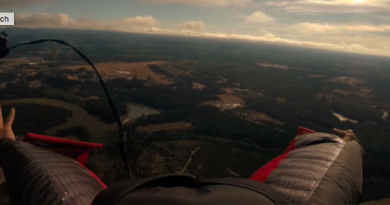the Snatch -Pl for Wingsuite
The Snatch

The Snatch project began after a conversation between Squirrel Co-designer, Will Kitto, and CRW expert, Jim Rasmussen. Although the toroidal design concept has been used extensively in parachutes for over 40 years (it is also known as an annular or pulled-down-apex (PDA) design), it has never before been adopted for BASE or skydive pilot chutes due to the complexity of the design being cost and production prohibitive.
However, with access to an advanced production facility and with no barriers for cost of production, producing the toroidal design is viable.

The Design
The Snatch’s three dimensional partial toroidal shape is joined together with two mesh cones. The torus shape, like a donut cut in half, has a very high drag coefficient. “Traditional” base and skydiving pilot chutes are a very loose approximation of this same shape. Traditional PCs are two circles sewn together around the edges, typically one of ZP and one of mesh, with a piece of line or webbing connecting the center of each circle together at a specific distance. When pulled from the center of the mesh circle and dragged through a fluid, it inflates into a rough approximation of a pulled-down-apex shape, but with a large amount of distortion and error, with a wrinkled and asymmetric circumference. Imagine crumpling up a single piece of paper until it forms the 3D shape you want to design – it won’t look good, nor be an accurate representation of a 3D surface. Yet that is the current basis of traditional PCs: an approximate and inefficient 2D design meant to perform a task that requires a 3D shape.
The Snatch’s design achieves a specific 3D shape when inflated by using multiple panels (gores), each with a mathematically calculated 3D shape. The design is similar to the way that round parachutes are designed from multiple gores to form a hemispherical shape when inflated.

The Math
A torus is made by rotating an ellipse around a center axis. For this design, we used an ellipse with a ratio of 7:10 (height : width) with an axis offset from the ellipse by 20% of its width. Mesh cones meet with the outside and inside edges of the partial torus at an exact tangent to its curve, ensuring a smooth transition from mesh to ZP, which maintains a smooth and error-free perimeter of the pilot chute. The difference between a Snatch and a traditional PC design is immediately apparent when handled or inflated by any experienced jumper.
How it works more efficiently
The inherent imperfection of the standard double circle pilot chute design means that there is a significant amount of randomness in its inflated shape. There is a constant tug-of-war between air pressure forcing it into a 3D shape, and the fabric trying to remain a 2D shape. Across its surfaces there are sections of high and low stress, where there is too much material in one section and not enough in another, causing “stretch and sag”. This can contribute to the pulsing and surging we see in traditional pilot chutes in freefall. A toroidal design minimizes the randomness and helps to ensure that the inflation is more consistent and predictable. Once inflated, the pilot chute is not searching for alternative shapes: it inflates to its intended shape and stays there. There is no pulsing, and instead only a clean inflated shape.



What does this mean for the jumper?
Per square millimeter, the Snatch pulls with more stability than a traditional PC. Wind tunnel and field testing have shown vastly superior stability in all BASE applications, from low slider-down to wingsuit and tracking deployments.
Weight, balance and materials
We believe pilot chute weight to be a critical safety factor. For over a decade now, the BASE community has known that hackysack handles are bad, and contribute to PC/bridle entanglements because of their weight. Yet there are still countless PCs in use today which feature heavy and bulky PVC handles, excessive load tape, and overbuilt/clumsy construction. Evidence suggests that lighter is better, and for that reason we have created the lightest design that we could without sacrificing reasonable durability. A lighter PC is less likely to entangle with the bridle: it tumbles less, and is carried downstream at rates more similar to the bridle. A heavier PC can be carried downstream at a slower rate than the bridle, which can cause the heavy PC to then tumble and mix with the bridle in the jumper’s burble.
Hexagonal Handle
The hexagonal carbon-fiber handle design is the result of our lightweight obsession. It provides a distinct easy-to-feel shape, with the absolute minimum in weight. The carbon hex is present on the 32, 34, 36, and 38” sizes. The 42 size features a pad-patch top, with no carbon. The 46 and 48 are handle-free, for hand-held use.
Each Snatch is guaranteed to be symmetric in construction. PC symmetry is critical – while there are many factors that can cause a pilot chute to exhibit unstable behavior, ensuring that your PC is built symmetrically is important to ensuring stable parachute extractions. The Snatch is built to +/- 1mm tolerances. Outside load tapes and the center line meet together at a single bridle attachment point, for ease of attachment and symmetry.
Free Designs For All
The toroidal concept was not invented by Squirrel, and has been in use in the military and civilian parachute industries for decades. Squirrel feels that the benefits of this design are such that all BASE jumpers should consider using it. For that reason, the Snatch patterns can be downloaded for free, contact Squirrel to receive the link. All sizes are available, in 2D patterns ready to be printed or plotted, and sewn. The files available can be opened with all common CAD programs, many of which can be found for free online.
For more information see Snatch on Squirrel




